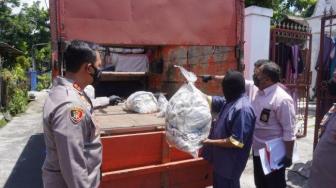TheIndonesia.id - Three students of Jenderal Sudirman University (Unsoed) Purwokerto, Banyumas Regency, Central Java, developed a drone-based pest control tool for rice plants. The Unsoed student supervisor, Dr. Ardiansyah, in a statement in Purwokerto, Friday, said the three students were Tiara Nur Azmi Irawati from the Agricultural Engineering Department, Syahra Alifia from the Electrical Engineering Department, and Pudak Wangi Kencana Rinonce from the Food Technology Department.
"They took the initiative to develop pest control devices using UAVs (Unmanned Aerial Vehicles) or drones," he said.
According to him, the activity of making this device was funded by the Ministry of Education, Culture, Research, and Technology (Kemdikbudristek) through the Student Creativity Program (PKM) scheme.
Meanwhile, Tiara Nur Azmi Irawati said that planthoppers are the most dangerous and harmful rice pests, especially in Indonesia because these tiny insects suck the sap of the rice plant as well as spread the virus that causes rice plants to become infected with tungro disease, resulting in crop failure. Tungro is a disease caused by two different types of viruses, namely Rice Tungro Bacilliform Virus and Rice Tungro Spherical Virus. The two types of viruses have no serologic relationship and can infect plants together.
"Currently, rice plants in Indonesia are very vulnerable to planthopper pests. This is proven by several years of cases that have disturbed farmers due to outbreaks of leafhoppers," she said.
Based on the Central Statistics Agency (BPS) data in 2020 classified by province for the 2018-2020 period, it showed a decline in rice harvested area from 2018 to 2020, from 11,377,934.44 hectares to 10,786,814.17 hectares. Based on the BPS data, she said, the productivity of the rice harvest has also decreased drastically from 59,200,533.72 tons to 55,160,548.20 tons.
"Referring to the statement, the spread of rice planthopper pests poses a threat to increasing agricultural productivity, especially rice," she said.
Thus, she said, a breakthrough in the role of technology is needed that can assist farmers in overcoming the spread of leafhoppers on rice plants so that they do not interfere with the growth of rice plants. To contribute to providing solutions to these problems, the Agricultural Engineering Department student and two colleagues took the initiative to develop a pest control device using drones.
How it works
"This idea stems from an earlier problem, where ultrasonic midges were placed on a stationary pole," she said.
If the ultrasonic midges are placed in the rice fields, it is necessary to place poles in several locations. However, she continued, the existence of these poles could interfere with the work of farmers' fields.
"Therefore, these midges are flown by drones. Before being flown, their flight trajectories are created and set to stay for a specified duration at certain points," Irawati said.
Furthermore, Irawati said the innovation of using drones and ultrasonics in rice fields aims to control the brown planthopper pest in a larger area. In addition, she said, the device is very supportive of sustainable agriculture because it does not require chemicals or pesticides.
"This pest control device is portable, so it can't only be used in one place. The power used in this tool uses a power bank, so there is no need for continuous electricity," she said.
The method that will be used is to utilize five ultrasonic sensors which are assembled using a microcontroller to read the pulse width modulation (PWM) for calculating the area resulting from ultrasonic wave emission. According to her, the circuit is then connected to a drone that is designed to be flown over land.
"The way this tool works is that the drone will fly according to the circuit that has been made. Then the signal is emitted by an ultrasonic transmitter with a certain frequency and with a certain duration of time," she said.
Irawati said the signal has a frequency above 40 kHz and will measure the distance of objects (proximity sensors). The signal emitted will propagate as sound waves with a speed of about 340 m/s.
When pounding the planthopper, she said, the signal will be reflected by the object and will produce a sound that can disrupt the metabolism of the planthopper. This is due to the ultrasonic sound of more than 20 kHz communication disturbances of planthoppers, inhibiting breeding, disrupting movement reaction patterns, and dissolving from the community, while at higher frequencies it can cause passive motion reactions until the pests die.
"In the future, this tool will be developed with an intelligent system for detecting pest-intensive locations, so that the length and position of residence varies. Computer vision technology is needed to make this happen," said Tiara Nur Azmi Irawati.








